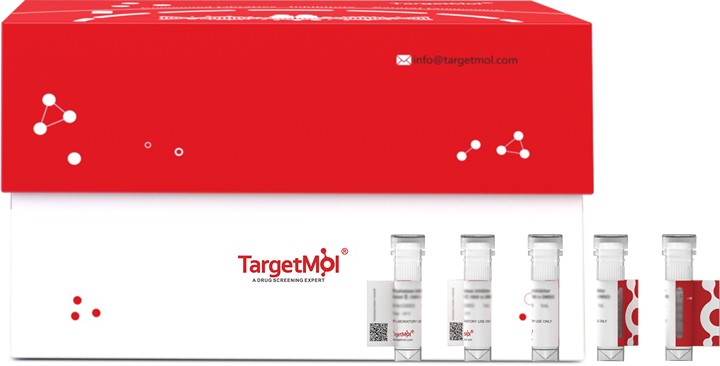- Remove All
 Your shopping cart is currently empty
Your shopping cart is currently empty
KPNB1 Protein, Human, Recombinant (His)
Importin subunit beta-1(KPNB1) is a member of the importin beta family. KPNB1 contains 1 importin N-terminal domain and 19 HEAT repeats. It is involved in nucleocytoplasmic transport, a signal- and energy-dependent process, takes place through nuclear pore complexes embedded in the nuclear envelope. Its functions in nuclear protein import, either in association with an adapter protein, like an importin-alpha subunit, which binds to nuclear localization signals (NLS) in cargo substrates, or by acting as autonomous nuclear transport receptor. The import of proteins containing a classical nuclear localization signal (NLS) requires the NLS import receptor, a heterodimer of importin alpha and beta subunits. Each of these subunits is part of the karyopherin family of proteins. Importin alpha binds the NLS-containing cargo in the cytoplasm and importin beta docks the complex at the cytoplasmic side of the nuclear pore complex. It mediates autonomously the nuclear import of ribosomal proteins RPL23A, RPS7 and RPL5.

KPNB1 Protein, Human, Recombinant (His)
| Pack Size | Price | Availability | Quantity |
|---|---|---|---|
| 5 μg | $112 | 7-10 days | |
| 10 μg | $183 | 7-10 days | |
| 20 μg | $292 | 7-10 days | |
| 50 μg | $545 | 7-10 days | |
| 100 μg | $813 | 7-10 days | |
| 200 μg | $1,190 | 7-10 days | |
| 500 μg | $2,070 | 7-10 days | |
| 1 mg | $2,970 | 7-10 days |
Product Information
| Biological Activity | Activity has not been tested. It is theoretically active, but we cannot guarantee it. If you require protein activity, we recommend choosing the eukaryotic expression version first. |
| Description | Importin subunit beta-1(KPNB1) is a member of the importin beta family. KPNB1 contains 1 importin N-terminal domain and 19 HEAT repeats. It is involved in nucleocytoplasmic transport, a signal- and energy-dependent process, takes place through nuclear pore complexes embedded in the nuclear envelope. Its functions in nuclear protein import, either in association with an adapter protein, like an importin-alpha subunit, which binds to nuclear localization signals (NLS) in cargo substrates, or by acting as autonomous nuclear transport receptor. The import of proteins containing a classical nuclear localization signal (NLS) requires the NLS import receptor, a heterodimer of importin alpha and beta subunits. Each of these subunits is part of the karyopherin family of proteins. Importin alpha binds the NLS-containing cargo in the cytoplasm and importin beta docks the complex at the cytoplasmic side of the nuclear pore complex. It mediates autonomously the nuclear import of ribosomal proteins RPL23A, RPS7 and RPL5. |
| Species | Human |
| Expression System | E. coli |
| Tag | N-6xHis |
| Accession Number | Q14974 |
| Synonyms | PTAC97,Pore targeting complex 97 kDa subunit,Nuclear factor p97,NTF97,KPNB1,Karyopherin subunit β-1,Karyopherin subunit beta-1,Importin-90,Importin subunit β-1,Importin subunit beta-1 |
| Amino Acid | Met1-Ala876 |
| Construction | Met1-Ala876 |
| Protein Purity | Greater than 85% as determined by reducing SDS-PAGE. (QC verified) |
| Molecular Weight | 90 KDa (reducing condition) |
| Endotoxin | < 0.1 ng/µg (1 EU/µg) as determined by LAL test. |
| Formulation | Supplied as a 0.2 μm filtered solution of 20 mM Tris-HCl, 1 mM DTT, 30% Glycerol, 100 mM Nacl, pH 8.0. |
| Stability & Storage | Lyophilized powders can be stably stored for over 12 months, while liquid products can be stored for 6-12 months at -80°C. For reconstituted protein solutions, the solution can be stored at -20°C to -80°C for at least 3 months. Please avoid multiple freeze-thaw cycles and store products in aliquots. |
| Shipping | Shipping with blue ice. |
| Research Background | Importin subunit beta-1(KPNB1) is a member of the importin beta family. KPNB1 contains 1 importin N-terminal domain and 19 HEAT repeats. It is involved in nucleocytoplasmic transport, a signal- and energy-dependent process, takes place through nuclear pore complexes embedded in the nuclear envelope. Its functions in nuclear protein import, either in association with an adapter protein, like an importin-alpha subunit, which binds to nuclear localization signals (NLS) in cargo substrates, or by acting as autonomous nuclear transport receptor. The import of proteins containing a classical nuclear localization signal (NLS) requires the NLS import receptor, a heterodimer of importin alpha and beta subunits. Each of these subunits is part of the karyopherin family of proteins. Importin alpha binds the NLS-containing cargo in the cytoplasm and importin beta docks the complex at the cytoplasmic side of the nuclear pore complex. It mediates autonomously the nuclear import of ribosomal proteins RPL23A, RPS7 and RPL5. |
Dose Conversion
Sci Citations
Calculator
Tech Support

Copyright © 2015-2025 TargetMol Chemicals Inc. All Rights Reserved.


